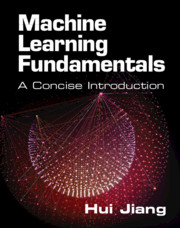Refine listing
Actions for selected content:
9096 results in Communications, Signal Processing and Information Theory
1 - Introduction
-
- Book:
- Machine Learning Fundamentals
- Published online:
- 18 November 2021
- Print publication:
- 25 November 2021, pp 1-18
-
- Chapter
- Export citation
Frontmatter
-
- Book:
- Machine Learning Fundamentals
- Published online:
- 18 November 2021
- Print publication:
- 25 November 2021, pp i-iv
-
- Chapter
- Export citation
Index
-
- Book:
- Machine Learning Fundamentals
- Published online:
- 18 November 2021
- Print publication:
- 25 November 2021, pp 397-404
-
- Chapter
- Export citation
13 - Entangled Models
- from GENERATIVE MODELS
-
- Book:
- Machine Learning Fundamentals
- Published online:
- 18 November 2021
- Print publication:
- 25 November 2021, pp 291-310
-
- Chapter
- Export citation
Contents
-
- Book:
- Machine Learning Fundamentals
- Published online:
- 18 November 2021
- Print publication:
- 25 November 2021, pp v-x
-
- Chapter
- Export citation
APPENDIX
-
- Book:
- Machine Learning Fundamentals
- Published online:
- 18 November 2021
- Print publication:
- 25 November 2021, pp 375-376
-
- Chapter
- Export citation
3 - Supervised Machine Learning (in a Nutshell)
-
- Book:
- Machine Learning Fundamentals
- Published online:
- 18 November 2021
- Print publication:
- 25 November 2021, pp 67-76
-
- Chapter
- Export citation
10 - Overview of Generative Models
- from GENERATIVE MODELS
-
- Book:
- Machine Learning Fundamentals
- Published online:
- 18 November 2021
- Print publication:
- 25 November 2021, pp 221-238
-
- Chapter
- Export citation

Machine Learning Fundamentals
- A Concise Introduction
-
- Published online:
- 18 November 2021
- Print publication:
- 25 November 2021
20 - Many Servers with Abandonment
- from Part VI - Many-Server Systems
-
- Book:
- Scheduling and Control of Queueing Networks
- Published online:
- 01 October 2021
- Print publication:
- 14 October 2021, pp 346-359
-
- Chapter
- Export citation
12 - Processing Networks and Maximum Pressure Policies
- from Part IV - Fluid Models of Multi-Class Queueing
-
- Book:
- Scheduling and Control of Queueing Networks
- Published online:
- 01 October 2021
- Print publication:
- 14 October 2021, pp 197-218
-
- Chapter
- Export citation
4 - The G/G/1 Queue
- from Part II - Approximations of the Single Queue
-
- Book:
- Scheduling and Control of Queueing Networks
- Published online:
- 01 October 2021
- Print publication:
- 14 October 2021, pp 61-70
-
- Chapter
- Export citation
8 - Product-Form Queueing Networks
- from Part III - Queueing Networks
-
- Book:
- Scheduling and Control of Queueing Networks
- Published online:
- 01 October 2021
- Print publication:
- 14 October 2021, pp 125-142
-
- Chapter
- Export citation
18 - Infinite Servers Revisited
- from Part VI - Many-Server Systems
-
- Book:
- Scheduling and Control of Queueing Networks
- Published online:
- 01 October 2021
- Print publication:
- 14 October 2021, pp 323-329
-
- Chapter
- Export citation
Part VI - Many-Server Systems
-
- Book:
- Scheduling and Control of Queueing Networks
- Published online:
- 01 October 2021
- Print publication:
- 14 October 2021, pp 321-322
-
- Chapter
- Export citation
9 - Generalized Jackson Networks
- from Part III - Queueing Networks
-
- Book:
- Scheduling and Control of Queueing Networks
- Published online:
- 01 October 2021
- Print publication:
- 14 October 2021, pp 143-156
-
- Chapter
- Export citation
16 - Control in Balanced Heavy Traffic
- from Part V - Diffusion Scaled Balanced Heavy Traffic
-
- Book:
- Scheduling and Control of Queueing Networks
- Published online:
- 01 October 2021
- Print publication:
- 14 October 2021, pp 270-304
-
- Chapter
- Export citation
22 - Parallel Servers with Skill-Based Routing
- from Part VI - Many-Server Systems
-
- Book:
- Scheduling and Control of Queueing Networks
- Published online:
- 01 October 2021
- Print publication:
- 14 October 2021, pp 385-412
-
- Chapter
- Export citation
11 - Stability of MCQN via Fluid Limits
- from Part IV - Fluid Models of Multi-Class Queueing
-
- Book:
- Scheduling and Control of Queueing Networks
- Published online:
- 01 October 2021
- Print publication:
- 14 October 2021, pp 175-196
-
- Chapter
- Export citation
7 - Diffusions and Brownian Processes
- from Part II - Approximations of the Single Queue
-
- Book:
- Scheduling and Control of Queueing Networks
- Published online:
- 01 October 2021
- Print publication:
- 14 October 2021, pp 102-122
-
- Chapter
- Export citation
